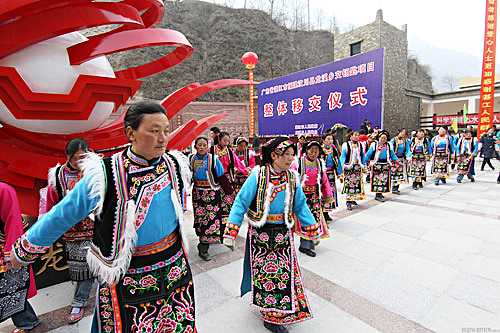|
 |
|
CELEBRATING GENEROSITY: Ethnic Qiang villagers dance at a ceremony for the handover of 14 projects that were built by Zhanjiang, Guangdong Province, for earthquake-devastated Longxi Town, Wenchuan County, on January 23, 2010 (ZHAO XI) |
On November 15, 2008, Guangdong submitted its plan to Wenchuan's county headquarters and townships. Four days later, Sichuan Provincial Government's housing and urban-rural development department appraisal committee approved it.
Yingxiu Town, at the earthquake's epicenter, was the toughest reconstruction work for relief workers, as the whole town had collapsed into rubble. Guangdong organized a design competition to find the most suitable reconstruction plan for Yingxiu, which was adopted by the appraisal committee on December 30, 2008.
Scientific planning
Minimizing residents' potential losses in future earthquakes has become a priority in formulating the reconstruction plan since Wenchuan is in an active seismic zone.
The Guangdong team completed a seismic hazard map of Wenchuan's planned construction areas, relocated industrial and public service facilities according to what they found and concentrated populations in relatively safer areas.
The team has imposed high quality standards on all of the new architecture. The plan says that all new buildings, whether they are homes or educational, health, cultural or sports facilities, must be able to survive 8.0-magnitude earthquakes.
Around 80 percent of Guangdong's aid budget will be used to rebuild people's livelihoods. Equal access to public services for urban and rural residents is also being taken into consideration.
The plan includes the construction of a 4.5-square-km industrial park in Wenchuan, which has attracted a number of Guangdong-based companies due to government incentives associated with the its creation. Officials expect the park to be put into operation in 2014. Contracts have already been signed with companies that are worth more than 4 billion yuan ($588 million).
Major Reconstruction Projects
Rural Housing: A total of 782 million yuan ($115 million) has been allocated for rebuilding and consolidating rural homes. Beside the 1,655 households that are about to move into new homes ahead of the Spring Festival, 16,694 families have already moved into their newly built or repaired homes.
Urban Housing: A total of 1.39 billion yuan ($204 million) is earmarked to assist urban housing reconstruction. Crews completed all projects by the end of 2009.
Medical Facilities: A total of 269 million yuan ($39.6 million) has been designated to rebuild medical facilities. The total area of newly built facilities is 60,000 square meters, which is 1.6 times that which was available before the earthquake. There are 462 new inpatient hospital beds, which is an increase of 40 percent compared with the number before the earthquake. Guangdong has also sent 1,544 medical staff members to Wenchuan to provide medical services and train doctors, nurses, medical equipment operators and hospital management personnel.
Water Facilities: Before the earthquake, Wenchuan had only two water treatment plants, with a combined supply capacity of 7,000 tons per day. Guangdong spent 221 million yuan ($32.5 million) on 47 projects to repair and upgrade urban water supply infrastructure. Daily capacity rose to 18,100 tons.
Transportation Facilities: The earthquake destroyed 340.3 km of rural roads and 80 km of urban roads. About 60 percent of the county's concrete and asphalt roads and three bridges were destructed. Guangdong donated 1.53 billion yuan ($224 million) to restore roadways, which has resulted in the rebuilding of 208 km of urban roads and 252 km of rural roads.
Social Welfare Facilities: Wenchuan had only one social assistance and welfare service center before the earthquake, with a total area of 3,600 square meters and 150 beds. Guangdong allocated 72 million yuan ($10.6 million) for social welfare projects. Two social welfare centers have been built with a total area of 13,849 square meters and 540 beds.
Leisure and Sports Facilities: Before the earthquake, Wenchuan's libraries, leisure centers and bookstores were small in number and scale and the county had no public sports venue. Guangdong spent 172 million yuan ($25.3 million) on 28 leisure and sports facilities projects.
Rural Public Service Facilities: Guangdong donated 71.3 million yuan ($10.5 million) to build rural public service centers totaling an area of 46,400 square meters.
Logistics Facilities for Agricultural Products: Guangdong allocated 67.3 million yuan ($9.9 million) to build 10 agricultural products markets in 13 Wenchuan townships. Ten markets have been completed after an investment of 49.8 million yuan ($7.3 million).
Disaster Shelters: The earthquake's environmental destruction to Wenchuan has made the county prone to secondary disasters, such as landslides, mudslides and the collapse of river embankments. Guangdong earmarked 542 million yuan ($79.7 million) to build new disaster shelters. Nineteen shelter facilities have been completed that cost 124 million yuan ($18.2 million). | 